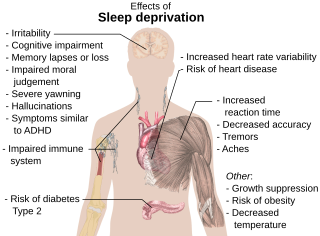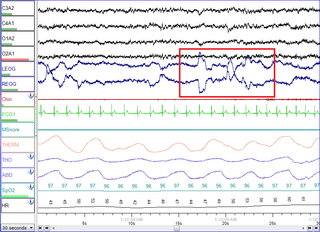Related Research Articles

Delayed sleep phase disorder (DSPD), more often known as delayed sleep phase syndrome and also as delayed sleep–wake phase disorder, is the delaying of a person's circadian rhythm compared to those of societal norms. The disorder affects the timing of biological rhythms including sleep, peak period of alertness, core body temperature, and hormonal cycles.
Advanced Sleep Phase Disorder (ASPD), also known as the advanced sleep-phase type (ASPT) of circadian rhythm sleep disorder, is a condition that is characterized by a recurrent pattern of early evening sleepiness and very early morning awakening. This sleep phase advancement can interfere with daily social and work schedules, and results in shortened sleep duration and excessive daytime sleepiness. The timing of sleep and melatonin levels are regulated by the body's central circadian clock, which is located in the suprachiasmatic nucleus in the hypothalamus.

Sleep debt or sleep deficit is the cumulative effect of not getting enough sleep. A large sleep debt may lead to mental or physical fatigue, and can adversely affect one's mood, energy, and ability to think clearly.
William Charles Dement was an American sleep researcher and founder of the Sleep Research Center at Stanford University. He was a leading authority on sleep, sleep deprivation and the diagnosis and treatment of sleep disorders such as sleep apnea and narcolepsy. For this pioneering work in a previously uncharted field in the United States, he is sometimes referred to as the American father of sleep medicine.
Somnolence is a state of strong desire for sleep, or sleeping for unusually long periods. It has distinct meanings and causes. It can refer to the usual state preceding falling asleep, the condition of being in a drowsy state due to circadian rhythm disorders, or a symptom of other health problems. It can be accompanied by lethargy, weakness and lack of mental agility.
Hypersomnia is a neurological disorder of excessive time spent sleeping or excessive sleepiness. It can have many possible causes and can cause distress and problems with functioning. In the fifth edition of the Diagnostic and Statistical Manual of Mental Disorders (DSM-5), hypersomnolence, of which there are several subtypes, appears under sleep-wake disorders.

Polysomnography (PSG), a type of sleep study, is a multi-parameter study of sleep and a diagnostic tool in sleep medicine. The test result is called a polysomnogram, also abbreviated PSG. The name is derived from Greek and Latin roots: the Greek πολύς, the Latin somnus ("sleep"), and the Greek γράφειν.

Somnology is the scientific study of sleep. It includes clinical study and treatment of sleep disorders and irregularities. Sleep medicine is a subset of somnology.
The Multiple Sleep Latency Test (MSLT) is a sleep disorder diagnostic tool. It is used to measure the time elapsed from the start of a daytime nap period to the first signs of sleep, called sleep latency. The test is based on the idea that the sleepier people are, the faster they will fall asleep.
The Epworth Sleepiness Scale (ESS) is a scale intended to measure daytime sleepiness that is measured by use of a very short questionnaire. This can be helpful in diagnosing sleep disorders. It was introduced in 1991 by Dr Murray Johns of Epworth Hospital in Melbourne, Australia.
Excessive daytime sleepiness (EDS) is characterized by persistent sleepiness and often a general lack of energy, even during the day after apparently adequate or even prolonged nighttime sleep. EDS can be considered as a broad condition encompassing several sleep disorders where increased sleep is a symptom, or as a symptom of another underlying disorder like narcolepsy, circadian rhythm sleep disorder, sleep apnea or idiopathic hypersomnia.
The sleep–wake activity inventory (SWAI) is a subjective multidimensional questionnaire intended to measure sleepiness.
Mary A. Carskadon is one of the most prominent American researchers in sleep. She is a Professor in the Department of Psychiatry and Human Behavior at the Warren Alpert Medical School of Brown University. She is also the Director of the Sleep and Chronobiology Research Lab at E.P. Bradley Hospital. She is considered to be an expert on sleep and circadian rhythms during childhood, adolescence and young adulthood. She researches issues related to daytime sleepiness. She has also contributed important research on school start times as it relates to sleep patterns and sleepiness in adolescence. Every summer, Dr. Carskadon offers a prestigious summer internship for highly motivated students interested in sleep research at the Bradley Sleep Lab. These students, known as Dement Fellows, after William C. Dement, work in the sleep lab for the entirety of the summer and learn under Dr. Carskadon.

A sleep study is a test that records the activity of the body during sleep. There are five main types of sleep studies that use different methods to test for different sleep characteristics and disorders. These include simple sleep studies, polysomnography, multiple sleep latency tests (MSLTs), maintenance of wakefulness tests (MWTs), and home sleep tests (HSTs). In medicine, sleep studies have been useful in identifying and ruling out various sleep disorders. Sleep studies have also been valuable to psychology, in which they have provided insight into brain activity and the other physiological factors of both sleep disorders and normal sleep. This has allowed further research to be done on the relationship between sleep and behavioral and psychological factors.

Sleep deprivation, also known as sleep insufficiency or sleeplessness, is the condition of not having adequate duration and/or quality of sleep to support decent alertness, performance, and health. It can be either chronic or acute and may vary widely in severity. All known animals sleep or exhibit some form of sleep behavior, and the importance of sleep is self-evident for humans, as nearly a third of a person's life is spent sleeping.

Narcolepsy is a chronic neurological disorder that involves a decreased ability to regulate sleep–wake cycles. Symptoms often include periods of excessive daytime sleepiness and brief involuntary sleep episodes. Narcolepsy paired with cataplexy is evidenced to be an autoimmune disorder. These experiences of cataplexy can be brought on by strong emotions. Less commonly, there may be vivid hallucinations or an inability to move while falling asleep or waking up. People with narcolepsy tend to sleep about the same number of hours per day as people without it, but the quality of sleep tends to be lessened.
REM rebound is the lengthening and increasing frequency and depth of rapid eye movement (REM) sleep which occurs after periods of sleep deprivation. When people have been prevented from experiencing REM, they take less time than usual to attain the REM state. When people are unable to obtain an adequate amount of REM sleep, the pressure to obtain REM sleep builds up. When the subject is able to sleep, they will spend a higher percentage of the night in REM sleep.

Second wind, a colloquial name for the scientific term wake maintenance zone, is a sleep phenomenon in which a person, after a prolonged period of staying awake, temporarily ceases to feel drowsy, often making it difficult to fall asleep when exhausted. They are the result of circadian rhythms cycling into a phase of wakefulness. For example, many people experience the effects of a second wind in the early morning even after an entire night without sleep because it is the time when they would normally wake up.
Studies, which include laboratory investigations and field evaluations of population groups that are analogous to astronauts, provide compelling evidence that working long shifts for extended periods of time contributes to sleep deprivation and can cause performance decrements, health problems, and other detrimental consequences, including accidents, that can affect both the worker and others.

Sleep deprivation – the condition of not having enough sleep – is a common health issue for students in higher education. This issue has several underlying and negative consequences, but there are a few helpful improvements that students can make to reduce its frequency and severity.
References
- ↑ The Corsini Encyclopedia of Psychology. John Wiley & Sons. 2010. ISBN 9780470170236.
- 1 2 3 4 5 6 Dement, William C.; Vaughan, Christopher (1999). The Promise of Sleep: A Pioneer in Sleep Medicine Explores the Vital Connection Between Health, Happiness, and a Good Night's Sleep. Dell Trade Paperbacks. ISBN 0-440-50901-7.
- ↑ Seugnet L, Boero J, Gottschalk L, Duntley SP, Shaw PJ (December 2006). "Identification of a biomarker for sleep drive in flies and humans". Proc. Natl. Acad. Sci. U.S.A. 103 (52): 19913–8. Bibcode:2006PNAS..10319913S. doi: 10.1073/pnas.0609463104 . PMC 1750902 . PMID 17167051.